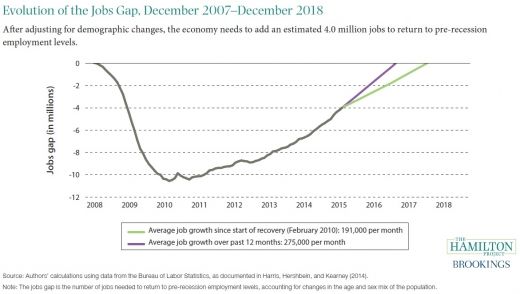Introduction
The Great Recession and the recovery that followed have demonstrated a clear need for policies to encourage job growth. The United States has experienced a fairly steady recovery—fifty-three consecutive months of positive job creation as of this writing—but there is room for continued improvement. As of March 2015 there are roughly 8.7 million unemployed Americans, 2.7 million of whom are classified as long-term unemployed (i.e., workers who have been unemployed longer than six months) (Bureau of Labor Statistics 2015b).
America currently faces a jobs gap of 4.0 million jobs, suggesting there is still slack in the labor market. (We define the jobs gap to be the number of jobs needed to return to pre-recession employment levels, accounting for changes in the population structure.) Figure 1 shows the evolution of this jobs gap since the start of the Great Recession in December 2007 and the length of time it will take to close the gap under different assumptions of growth. If the economy adds jobs at a rate of about 275,000 jobs per month, which is the average monthly rate of job creation over the past twelve months, then the economy will not reach pre-recession employment levels until September 2016.
In addition to this recent cyclical challenge, the past fifteen years have witnessed what appear to be longerterm changes in labor force participation rates. Since the year 2000 labor markets have been relatively sluggish, even during periods of job growth. As documented in The Hamilton Project’s economic analysis earlier this month, the jobs gaps from successive recessions are taking longer to close, as compared to earlier recessions and recoveries (Hershbein and Kearney 2015). For both men and women, the employment-to-population ratio among individuals aged eighteen to sixty-four has been on a downward trend since 2000. For men this continues a multi-decade decline in employment levels: the employment-to-population ratio for men fell from 86.5 percent in 1970 to 81.9 percent in 2000, and continued to fall to 74.6 percent by 2014. The recent downward trend reflects a reversal for women, however: between 1970 and 2000 the female employment-to-population ratio rose from 47.6 percent to 69.8 percent, but has since declined to 64.9 percent (authors’ calculations using the Current Population Survey, March Supplement).
As the labor market continues to evolve, our nation will face pressing questions about how to address both cyclical and longer-term labor market challenges and, ultimately, about how best to help workers secure steady jobs. The appropriate response to these challenges will involve a range of policies, targeting both short-term and long-term issues.
Figure 1

This framing memo from The Hamilton Project discusses three proposals from prominent scholars, each of which addresses a specific challenge in a potentially cost-effective way. To date, these particular ideas have received little policy attention. While none of these proposals alone would close the jobs gap or dramatically increase aggregate employment rates, each is meant to complement, rather than substitute for, more-traditional approaches to stimulate job growth. As such, these proposals offer significant potential to broaden job opportunities for Americans.


